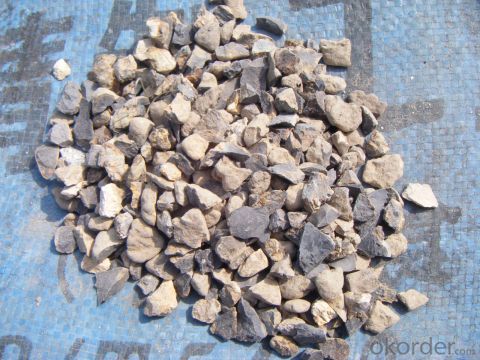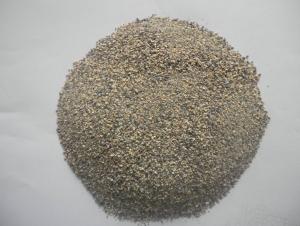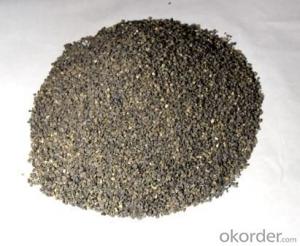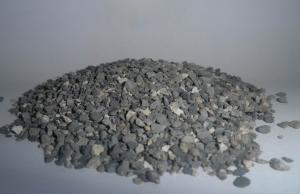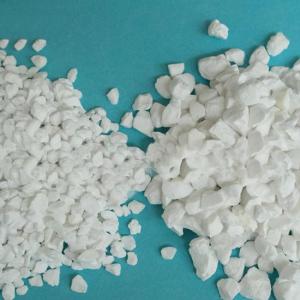Calcined Bauxite Raw Materials for Refractory Industry
- Loading Port:
- China main port
- Payment Terms:
- TT OR LC
- Min Order Qty:
- 0 m.t.
- Supply Capability:
- 10000 m.t./month
OKorder Service Pledge
OKorder Financial Service
You Might Also Like
Calcined bauxite
High alumina bauxite or fine dust are made of high quality aluminum bauxite after firing in high temperature.Using aluminate cement as bonding agent , High alumina bauxite or fine dust can made kinds of shaped or unshaped refractory material.
Application:
Metallurgy
Petrochemical industry
Hydroelectric
Mechanical,
Precision casting.
Buliding industrial department
Calcined bauxite data sheet:
Al2O3% | SiO2% | FeO2% | CaO+MgO% | K2O+NaO% | Density% | TiO2% |
80 | 6-14 min | 2-3max | 0.4max | 0.05-1max | 2.9-3.2 | 3.5max |
85 | 6-14min | 2-3max | 0.4max | 0.05-1max | 2.9-3.2 | 3.5max |
87 | 6-14min | 2-3max | 0.4max | 0.05-1max | 2.9-3.2 | 3.5max |
88 | 6-14min | 2-3max | 0.4max | 0.05-1max | 2.9-3.2 | 3.5max |



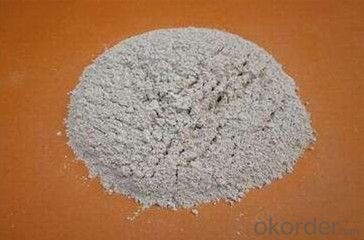
FAQ
Q: When can I?
A: We usually quote with 24 hour after we got your inquiry.
Q:Do you offer sample?
A:Yes, we offer the sample, you got the freight .
Q:Can you do the design for us?
A: Yes,we have professional team , just tell us your idea and we will help carry it out.
Our Service:
1. Your inquiry related to our products or prices will be replied in 24hours.
2. Manufacturer with large capacity, ensure the fast production cycle after confirmed the order.
- Q: A chemical problem with refractory materials
- Not necessarily. What you mean is silicate
- Q: Where is the production of refractory manganese alloy manufacturers? Manganese is recommended between 63 and 70!
- There are a lot of silicon manganese alloy manufacturers, production market is relatively large, the manganese content in manganese alloys between 63 to 70 or more common
- Q: Are fire materials poisonous after burning?
- Refractories burning after the smell of toxic, gases are generally silica, alumina, sulfur oxides and so onRefractory material is not less than 1580 degrees of refractoriness, better thermal shock resistance and chemical erosion, low thermal conductivity and low expansion coefficient of non-metallic materials. Acid refractory with silicon oxide as the main component, are commonly used in brick and clay brick. Silica is silica containing more than 94% silica products, raw materials used in silica, silica and other waste, the acid resistance of slag erosion ability, high load softening temperature, volume shrinkage after repeated burning, or even a slight expansion; but it is vulnerable to the erosion of basic slag, thermal shock resistance is poor. The brick is mainly used for thermal equipment of glass furnace, coke oven, acid furnace etc.. Clay brick with refractory clay as the main raw material, containing 30% to 46% of alumina, weak acid refractory material, refractory material, good heat shock resistance, resistance to acid slag, widely used.
- Q: How many kinds of fireproof materials are there in the market?
- A-level materials are the best which will not burn while the B-level materials are made of combustible materials which can burst into flames.
- Q: What's the heat conductivity coefficient of fire-resistant material?
- The heat conductivity coefficient of fire resistant material is related to bulk density and mainly related to the internal structure. Different materials have different structure and thermal conductivity and temperature . Carbonaceous material can be used for heat dissipation and reach more than 15. For thermal insulation it can be 0.00.
- Q: Which kind of refractory floor is easy to use? ?
- Fireproof wood floor includes three types, and according to your requirement, I think that the third type is more suitable or is easier to use. Here are the three types, and you can choose form them. A. Wear-resistant composite solid wood floor It is also known as super durable multi-layer solid wood floor. Its surface is inorganic glass fiber material and special paper impregnation thermosetting amino?resin, composited with solid wood base materials like plywood or core-board. And also, its front is wear-resistant layer while the back is balance layer, then hot press it into grooved and tongued floor. This is a new impregnated paper laminate floor. It also has the same wear-resistant quality as laminate floor, comfort as solid wood floor, and stability as composite board. B. Fire-resistant wood-plastic composite decking board Wood-plastic composite decking board is not the wood floor in the traditional sense, but a composite material, also known as plastic wood. It is formed by high molecular improving and processing natural fiber, such as recycled plastic and wood fiber. It not only has the same advantages as plastic and wood, but alos has certain fire resistance, thus it is a environmentally friendly material with much development potential. C. Fireproof strengthened composite wood floor It is the so-called fireproof and fire retardant floor, fiber board, plywood and chipboard as its base materials. It is coated with fireproof coating and impregnated paper, and after fireproof and fire retardant technical process, it becomes a composite wood floor with some fire?retardant level. Its features are more partial to that of laminate floor with stable performance, steady structure and good durability.
- Q: What is the most reasonable drying heating curve of magnesia refractories? Products of less than 0.5T
- o
- Q: How should refractory cement be used?
- How to use refractory cement? How to use refractory cement? Thank you.
- Q: Does refractory belong to stone, building materials or other?
- It belongs to metallurgy and building material industries.
- Q: How to classify fire resistance rating of brick-concrete structure?
- In order to ensure the safety of the building, the fire protection measures must be taken to make it have a certain degree of fire resistance, even if there is a fire, it will not cause too much damage. According to the national conditions of our country, and in the light of other countries standards, < high-rise civil building fire protection design specification > defines fireproof rank of high-rise civil buildings into level one and two; < code for fire protection design of buildings > divides the rank into level one, two, three, four, level one is the highest level, level four is the lowest. Besides that the minimum fire resistance of the building component is specified, buildings of fire resistance rating also specified requirements for combustion performance. Because the component with the same fire resistance limit is different, it is different in the fire.According to our country national standard < building design fire protection code >, the fire resistance rating of the building is divided into four levels. The fire resistance of a building is determined by the combustion performance and fire resistance of building components (such as beams, columns, floors, walls, etc.). Generally speaking, the fire resistance building of level one is a mixed structure of reinforced concrete structure or a mixture of brick wall and steel concrete structure; the fire resistance building of level two is a mixed structure of steel truss structure, reinforced concrete column and brick wall; the fire resistance building of level three is brick-wood structure made of wood roof and brick wall; the fire resistance building of level four is combustible structure which is composed of wood roof and non-combustible wall.
Send your message to us
Calcined Bauxite Raw Materials for Refractory Industry
- Loading Port:
- China main port
- Payment Terms:
- TT OR LC
- Min Order Qty:
- 0 m.t.
- Supply Capability:
- 10000 m.t./month
OKorder Service Pledge
OKorder Financial Service
Similar products
Hot products
Hot Searches
Related keywords



